With everyone talking about Born of the Gods, I’ve decided to take things in a different direction this week. Recently I’ve been helping a friend learn the Legacy format, and during that process I’ve run across a few things that I believe would be helpful to a lot of players who are either just learning the format or want to get better at Legacy.
Besides a lot of the format staples being extremely expensive, the biggest hurdle for breaking into the Legacy format is the vast card pool and the myriad of decks that you can face. While having a conversation with my friend about the different decks that are available, I stumbled across a line of questioning that mainly had to do with deck recognition based off of turn 1 plays. This is very important because proper deck identification can help us determine what role we have to take in the game, how quickly we have to implement our game plan based on that role, and how we sequence our early turn plays.
Legacy as a format has an extremely low "fundamental turn," which is at its core the turn that you will kill your opponent. There are decks that can kill on the first turn, which means picking up on key information to try to identify your opponent’s deck is very important and can be the difference between winning and losing, especially if we’re playing a deck with cards like Ponder and Brainstorm where making decisions on which cards to keep or get rid of will play a huge part in our game plan and success.
If we sit down and think about the number of "viable" decks in Legacy, it’s quite a large list. We also have to take into account that as an Eternal format a lot of people will always play the same Legacy deck whether it’s considered viable or not. Let’s see just how big this list is (in no particular order).
RUG Delver
BUG Delver
U/W/R Delver
U/R Delver
Miracles
Reanimator
Sneak and Show
Omni-Tell
Death and Taxes
Imperial Painter
U/W Stoneblade
Esper Deathblade
Lands
Jund Depths
Elves
Ad Nauseam Tendrils
The Epic Storm
Jund
Dredge
Manaless Dredge
High Tide
Oops All Spells
Belcher
Goblins
Burn
Metalworker
U/B Tezzeret
BUG Control
Shardless BUG
That is a lot of decks, and I’m sure I missed some!
The last few are considered "fringe" decks, but they are definitely decks that you have to be aware of.
The exercise that I tried with my friend was an interesting one, and it goes a lot deeper than I thought since there are so many different options based on what our opponent does on turn 1. Here is the first scenario I presented my friend with.
"Your opponent is on the play and drops Arid Mesa, sacrifices for Volcanic Island, and casts Ponder. What deck are they playing?"
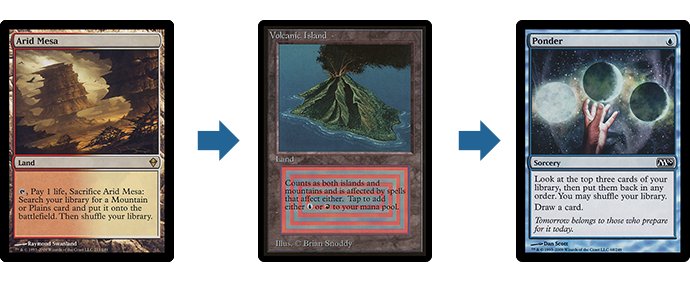
He paused for a few minutes and answered, "U/W/R Delver."
This was correct, but when I asked him why he came to that particular conclusion, all he could muster was that he saw those cards in my deck and on my registration sheet since I was playing U/W/R Delver that weekend.
When we look at it a bit deeper, we can see why this is the proper conclusion.
What decks play both Volcanic Island and Ponder?
RUG Delver, U/W/R Delver, U/R Delver, Omni-Tell, Sneak and Show, ANT, and TES are decks that play both of those cards. That’s a lot of decks! How can we narrow it down to just one?
Arid Mesa is the answer.
Omni-Tell, Sneak and Show, U/R Delver, and ANT all play basic Islands in their deck, which Arid Mesa cannot find. We can conclude that because of this it’s very unlikely that we’re playing against any of these decks. This is very important since these are the types of decks that can kill on turn 1 or 2.
RUG Delver plays Volcanic Island and Ponder; however, Arid Mesa cannot find Tropical Island, which means they definitely don’t play it.
It’s possible that the opponent is on Miracles since it does play Arid Mesa and Volcanic Island. But most Miracles lists have been foregoing Ponder, so until we see something that points in that direction I would keep Miracles in mind but not focus on it, not to mention that they would probably get a Tundra anyway to not expose their Volcanic Island to Wasteland.
This all leaves us with U/W/R Delver, which was correctly identified, but there was a lot more thinking that went along with it. This exercise led me to come up with some more that are very beneficial in helping learn what deck we can put our opponent on based on their turn 1 play.
What could our opponent be on if they lead with Wooded Foothills, "go?"
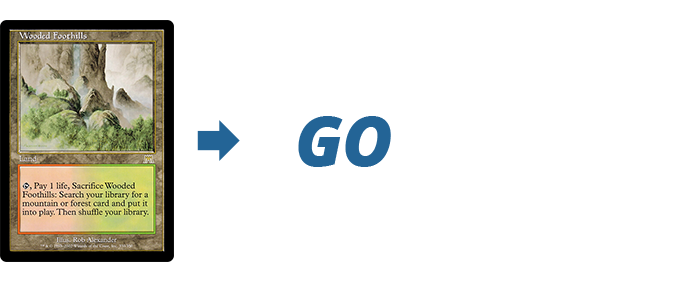
This one is pretty interesting because the decks that could possibly start like this are completely different and punish us from different angles.
The decks that play Wooded Foothills are RUG Delver, Burn, Goblins, Jund, Jund Depths, and Lands.
Many people have been caught by a surprise Stifle out of RUG Delver with Wooded Foothills, "go." The real clue for this matchup will come on turn 2 since all of the other decks besides RUG Delver are extremely proactive and want to be using their fetch lands as soon as they can because they all lack Brainstorm.
Thankfully there aren’t any decks that play Wooded Foothills that we have to worry about killing us on turn 1 or 2, so we can take our time to make sure we get good information. Playing around Stifle is very important, so a simple fetch land and pass from us isn’t all that bad.
Burn and Goblins are rarely going to just pass on turn 1 after playing a fetch land, whereas Jund, Jund Depths, and Lands are certainly capable of making this line of play but will rarely pass on turn 2 without doing something that will let us in on what they’re playing.
In this situation, I like playing it safe and either playing an actual dual land and a spell if we’re casting something that is one mana or just simply playing a fetch land and passing.
What could our opponent be on if they lead with Scalding Tarn, fetch for basic Island, and cast Ponder?
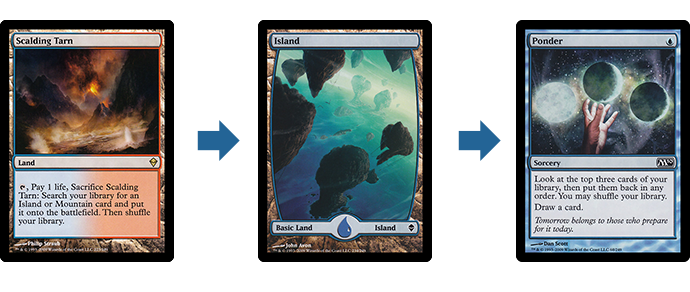
The big clue here is basic Island being fetched. This opening leads me to think that they are on Omni-Tell, Sneak and Show, ANT, Reanimator, High Tide, or possibly Miracles, but remember that most Miracles lists aren’t running Ponder.
All of these decks have the capability to kill very early, so we have to make decisions based on what we think they are playing quickly.
This is exactly what happened in one of my feature matches at the SCG Legacy Open in Baltimore when I was on Reanimator. I won the roll and played a fetch land and passed. He dropped a Scalding Tarn, fetched for basic Island, and cast Ponder. I instantly put him on Omni-Tell and used my Entomb to find Iona, Shield of Emeria instead of the standard Griselbrand and promptly won the game after I used Reanimate on Iona. He could have been on Sneak and Show or the mirror, but I find that most people aren’t going to play around Wasteland if they are on a combo deck with duals in it and will usually just fetch their duals. Even if he wasn’t on Omni-Tell, getting "Miss Super Booty" Iona into play on turn 2 naming blue against the other decks is still pretty good and should be enough to win.
What can we put our opponent on if they lead with Flooded Strand, fetch for Underground Sea, and cast Deathrite Shaman?
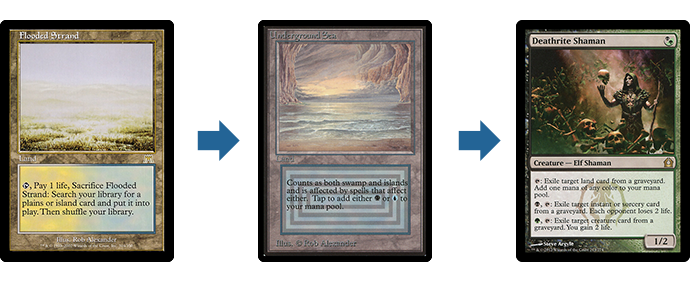
Not Modern, that’s for sure.
This is an interesting one because Deathrite Shaman is in quite a few decks so we have to narrow down what shell it’s in to help us identify what’s important in the matchup.
Decks that have Deathrite Shaman in it are Jund, Esper Deathblade, Elves, BUG Delver, and both BUG Control and Shardless BUG, which are a bit more fringe but definite possibilities.
Neither Jund nor Elves plays Underground Sea, so we can rule out both of those decks (unless Ross Merriam has decided to try to change Elves around without consulting Chris Andersen).
That leaves us with Esper Deathblade, BUG Delver, BUG Control, or Shardless BUG. In order to narrow it down even further, we need to look at the fetch land that searched out the Underground Sea.
Flooded Strand! Jinkeys gang, it’s a clue!
Based on a Flooded Strand finding the Underground Sea, we can conclude that we are more than likely looking at Esper Deathblade. The reason for this is that BUG Delver, BUG Control, and Shardless BUG all play Bayou and Flooded Strand is unable to search out a Bayou. Now, it’s possible that they’re playing zero Bayou and maxed out on Underground Sea and Tropical Island. But that’s highly unlikely, and even still they would be playing Polluted Delta, Misty Rainforest, and Verdant Catacombs before choosing Flooded Strand.
On the same note with Deathrite Shaman, what are the options if our opponent leads with Verdant Catacombs for Underground Sea?
The same decks all play Deathrite Shaman, and we can narrow down further to the same decks with Underground Sea along with the Deathrite Shaman. But the fetch land is the key here. Verdant Catacombs is unable to find Tundra, which lets us rule out Esper Deathblade and put our opponent on some sort of BUG deck, be it Shardless, Delver, or Control.
What are our options if our opponent leads with Wooded Foothills, finds Bayou, and casts Deathrite Shaman?
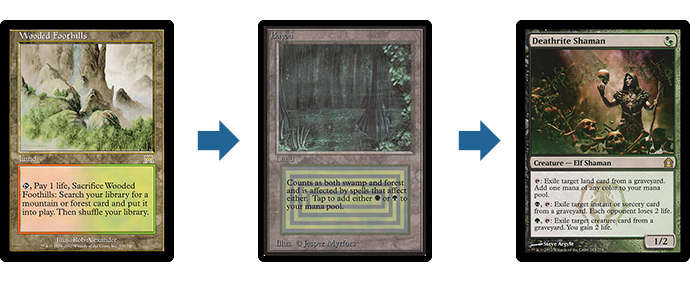
Here we have the same Deathrite Shaman, but rather than being cast off Underground Sea, we have Bayou. This lets us narrow the decks down to . . . all of the decks that have Deathrite Shaman in it.
That wasn’t very helpful.
The key is to look at the fetch land yet again. Wooded Foothills lets us narrow it even further to Elves or Jund. None of the BUG decks or Esper Deathblade will be playing Wooded Foothills, so we can rule those out.
We can even go one step further and try to rule out Elves. Most Elves decks don’t play any black spells in their maindeck, so finding a Bayou so early doesn’t really have any benefit and just exposes them to Wasteland. More than likely they would get a basic Forest. If they were trying to bait Wasteland, they would likely get a Savannah since they don’t even have any abilities in the maindeck that would use the white mana whereas Deathrite Shaman will benefit from the black mana generated by the Bayou later in the game. All of this leads me to believe that my opponent is on Jund and to sculpt my early turns accordingly.
There are also a lot of turn 1 plays that immediately give away what we’re up against, but we still have to be able to identify them properly. Cavern of Souls usually indicates Merfolk, Death and Taxes, or some other tribal strategy.
Gemstone Mine is another land that can tell us what we’re up against, and what they do with the land will solidify if it’s TES or Dredge. Don’t forget that if we lose the die roll and they put us on the play then it’s probably Manaless Dredge.
There are a whole slew of decks that are viable in Legacy, and by learning what they are and how you can identify them, we can greatly increase our chances of winning our Legacy matches. The format is full of powerful cards and strategies, and what we do in the first few turns is paramount to our success.
I hope that these exercises will help anyone who is looking to get into the Legacy format but is intimidated by the sheer number of decks that are available. Feel free to post in the comments any interesting turn 1 plays that could be helpful for someone trying to understand the format that I may have missed here. I’m still working with my friend to get him up to speed, so there’s a good chance I write more about the things that I’m learning from teaching him since I feel like there are a lot of people who want to play Legacy but haven’t dived in yet because of feeling intimidated.
I will be in Nashville this weekend battling some Born of the Gods Standard and Legacy. I’m pretty torn on what I’m going to play in Standard, but there’s a good chance that I’ll be jamming Griselbrand again for the Legacy portion.
